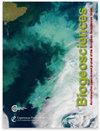响应El Niño-Southern振荡的生物源性挥发性有机化合物排放的变化
IF 3.9
2区 地球科学
Q1 ECOLOGY
引用次数: 0
摘要
摘要来自陆地生物圈的生物源性挥发性有机化合物(BVOCs)的排放在主要大气过程中发挥着重要作用。BVOCs是影响大气氧化能力的高活性化合物,也是影响全球辐射收支的气溶胶形成的前体。排放取决于植被对大气条件(主要是温度和光照)以及干旱和草食等其他压力的反应。El Niño-Southern涛动(ENSO)是由热带太平洋海表温度异常引起的自然循环。ENSO在全球和区域尺度上干扰天气系统的自然季节性,被认为是气候变率的最重要驱动因素。一些研究利用历史瞬态模拟评估了ENSO事件期间BVOC通量的敏感性。虽然这种方法采用了现实情景,但考虑到多种类型的气候强迫,例如人为排放的二氧化碳和气溶胶,很难单独评估ENSO的影响。在这项研究中,我们使用了一个具有相互作用植被的全球大气化学-气候模式进行了两组模拟:(1)孤立的ENSO事件模拟,其中单个ENSO事件被用来干扰基线条件;(2)持续的ENSO模拟,其中相同的ENSO条件在较长一段时间内重现。从孤立的ENSO事件中,我们得到了植被对大气状态的直接响应所导致的全球和区域BVOC排放变化。在将大气和植被变量与BVOC通量异常联系起来时,将更多的重点放在持续ENSO模拟上,这有利于减少内部变率,从而获得更稳健的统计数据。此外,这些模拟探讨了在这种可能的气候模式下生物圈的长期变化和植被的潜在变化,说明了随着气候变化ENSO强度和频率增加的前景。我们的研究结果表明,强烈的El Niño事件使全球异戊二烯排放通量增加了2.9%,并且单个ENSO事件对地球系统的扰动如此显著,以至于BVOC排放通量在事件发生后的几年内不会恢复到基线排放。我们发现,持续的ENSO条件将植被转移到一个新的准平衡状态,导致亚马逊河流域BVOC排放变化的放大,异戊二烯通量增加了19%。我们提供的证据表明,在持续ENSO气候模式下,BVOC引起的植物物候变化(如叶面积指数(LAI))对BVOC排放有显著影响。本文章由计算机程序翻译,如有差异,请以英文原文为准。
Changes in biogenic volatile organic compound emissions in response to the El Niño–Southern Oscillation
Abstract. Emissions of biogenic volatile organic compounds (BVOCs) from the terrestrial biosphere play a significant role in major atmospheric processes. BVOCs are highly reactive compounds that influence the atmosphere's oxidation capacity and also serve as precursors for the formation of aerosols that influence global radiation budgets. Emissions depend on the response of vegetation to atmospheric conditions (primarily temperature and light), as well as other stresses, e.g. from droughts and herbivory. The El Niño–Southern Oscillation (ENSO) is a naturally occurring cycle arising from anomalies in the sea surface temperature (SST) in the tropical Pacific. ENSO perturbs the natural seasonality of weather systems on both global and regional scales and is considered the most significant driver of climate variability. Several studies have evaluated the sensitivity of BVOC fluxes during ENSO events using historical transient simulations. While this approach employs realistic scenarios, it is difficult to assess the impact of ENSO alone given the multiple types of climate forcing, e.g. from anthropogenic emissions of CO2 and aerosol. In this study, a global atmospheric chemistry–climate model with enabled interactive vegetation was used to conduct two sets of simulations: (1) isolated ENSO event simulations, in which a single ENSO event is used to perturb otherwise baseline conditions, and (2) sustained ENSO simulations, in which the same ENSO conditions are reproduced for an extended period of time. From the isolated ENSO events, we present global and regional BVOC emission changes resulting from the immediate response of vegetation to atmospheric states. More focus is given to the sustained ENSO simulations, which have the benefit of reducing the internal variability for more robust statistics when linking atmospheric and vegetation variables with BVOC flux anomalies. Additionally, these simulations explore long-term changes in the biosphere with potential shifts in vegetation in this possible climate mode, accounting for the prospect of increased intensity and frequency of ENSO with climate change. Our results show that strong El Niño events increase global isoprene emission fluxes by 2.9 % and that one single ENSO event perturbs the Earth system so markedly that BVOC emission fluxes do not return to baseline emissions within several years after the event. We show that persistent ENSO conditions shift the vegetation to a new quasi-equilibrium state, leading to an amplification of BVOC emission changes with up to a 19 % increase in isoprene fluxes over the Amazon. We provide evidence that BVOC-induced changes in plant phenology, such as the leaf area index (LAI), have a significant influence on BVOC emissions in the sustained ENSO climate mode.
求助全文
通过发布文献求助,成功后即可免费获取论文全文。
去求助
来源期刊

Biogeosciences
环境科学-地球科学综合
CiteScore
8.60
自引率
8.20%
发文量
258
审稿时长
4.2 months
期刊介绍:
Biogeosciences (BG) is an international scientific journal dedicated to the publication and discussion of research articles, short communications and review papers on all aspects of the interactions between the biological, chemical and physical processes in terrestrial or extraterrestrial life with the geosphere, hydrosphere and atmosphere. The objective of the journal is to cut across the boundaries of established sciences and achieve an interdisciplinary view of these interactions. Experimental, conceptual and modelling approaches are welcome.
 求助内容:
求助内容: 应助结果提醒方式:
应助结果提醒方式:


